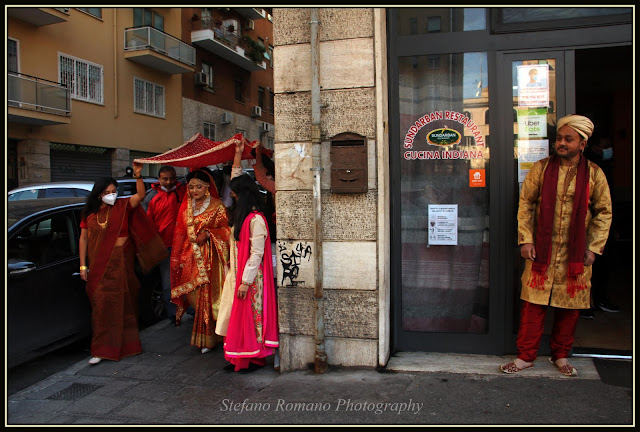One of the most fascinating novels I've ever read was “The Buddha in the Attic”, written by Julie Otsuka in 2011.
The novel tells, in the first
person, the story of the thousands of young Japanese women, the so-called
“brides in photography”, who – in the early twentieth century – embarked for
America, to join and marry the Japanese whom had moved there to work.
They met through the photographs
that men sent to them and, full of dreams and hopes, they left their family and
their land to start a new life. They will discover, as soon as they arrive, how
much difference and deception there will be in those photographs that they held
as the magic key that had transformed their simple existences.
As a photographer, that novel has
always been important in understanding the power of images; especially if
related to feelings and love.
It also happened to me many years
ago, when I started photographing the Bangladeshi community in Rome, that I was
asked to photograph some boys so that they would then print those photographs
to send them to their families in Bangladesh. My portraits were their chance to
find wives to bring here to Rome.
I was skeptical, but also impressed
to see how excited those guys were to pose in front of me.
Why am I telling you about this
story?
Because listening to Amin and
Nafisa's story reminded me in part of all this.
I didn't know them, I just had to
photograph their wedding. But the story of their love intrigued me.
Amin is a 32-year-old man, born in
Old Dhaka, but arrived in Rome when he was still really young, to the point of
having to learn his own culture. He feels Italian to all intents and purposes,
and even knew little about the wedding ritual itself.
Nafisa is a 25-year-old girl, born
in Rajshahi, the city located on the north bank of the Padma River, near the
border between Bangladesh and India.
Now everything moves on the silicon,
you can see it but you can't touch it.
In fact Amin, when I ask him how he
met Nafisa, he replies that it was thanks to an application on the phone:
“BangladeshiMatrimony”, a dating site on which it's possible to search for a
soul mate.
Just upload some photographs, write
a small biography, and set out in search of love.
It's not that easy.
It is true that having the family
brokerage in arranged marriages is a heavy burden, and often causes more
trouble instead of lasting happiness. But there is real evidence of those
profiles of candidates.
Instead, as Nafisa tells me, on that
site you have to be careful, most of the time people are fake. It's easy to
describe yourself if you are to grab someone's interest.
She herself refused other proposals,
from boys living in America as in Bangladesh, before accepting Amin.
And, beware, the first time Amin
spoke to Nafisa on the site, it was actually her brother who interacted. Then
when he realized that Amin was “real”, and with good intentions so he left
their freedom and privacy.
Nafisa already lived in Milan, in
the north of Italy, but she had returned to Bangladesh for eight months,
because she wanted to study the Koran and Arabic.
In October they met on that site,
and after a month they met for the first time in Rome. In three months they
decided to get married.
She will now live here in Rome.
And it's nice to see them finally
smile, release the tension after the officialization of the religious marriage
act with the imam.
It's not easy to get married during
this period.
The ceremonies must be with very few
people.
Nafisa had only her brother and one
relative with her. The family is far. Without friends.
But in the end, realizing that your
dream has come true dissolves all tension. And even a few people can be happy.
Then now with the phones you can see
in real time even between different countries.
That's why I liked starting with
that photograph, of the two of them before they met, on the two corners of the
street. Alone.
As a metaphor for their love story.
With the thought of young Japanese
women, on ships, with photographs of their betrothed in their hands.
I wish you much happiness Amin and
Nafisa.
For me it is always a great joy – as
you Amin wrote to me, in the evening when everything was over.
“Thanks again for sharing the best
day of our life with us.”
Good luck...
Torpignattara
ROME – 20 December, 2020
Julie Otsuka: “The Buddha in the
Attic” (2011)






















I speechless read about their love story.
ReplyDeleteWah..beautiful and sweet.
Congratulations Nafisa and Amin.
Thanks so much ☺️🙏
DeleteIt's really fascinating how u highlights the photographs as a 'medium' to find a soul partner... and it is actually still exist
ReplyDeletenowdays!
The methods still the same only differentiate by high technology used.
Love this article☺️
Thanks a lot 😊😊
DeleteAnother love story.. Thanks.. Makes us young again. Congratulations to the newly weds. Wishing them everlasting bliss.💐
ReplyDeleteAmazing photos and story about LDR's.
DeleteThank you thank you 😊🙏
DeleteI'm impressed with the way you start this article. Good job.
ReplyDeleteOne of trick of writing is the first lines... The most difficult like the last one, right? 😉😊
DeletePictures or letters or calls or messages...all those are just the cause.
ReplyDeleteLiking and loving someone exists in various ways.
If it is your mate...surely it belongs to you.
If it does not...it is just to fill the void of the story during life before death.
The door is the same, only the key changes 🗝️🔑😊
Delete